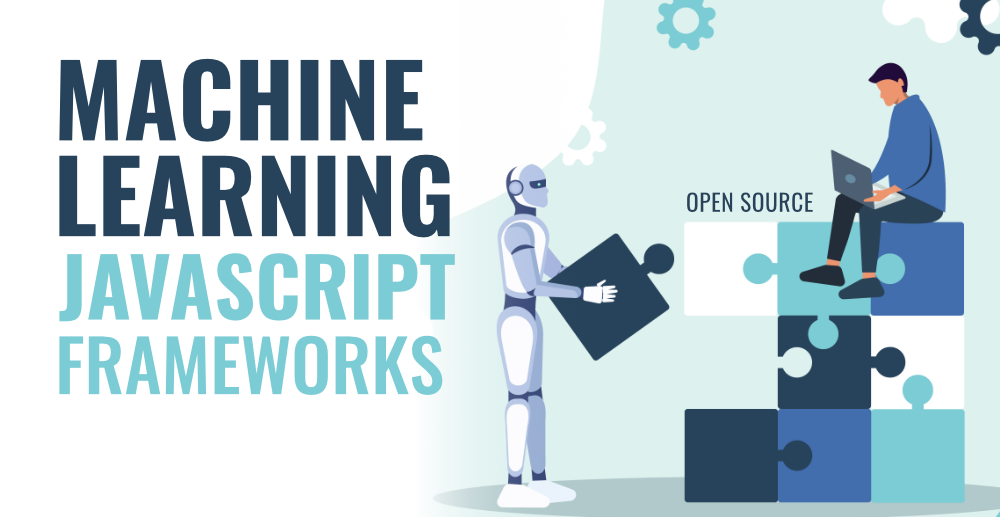6 Most Popular and Open-Source Machine Learning JavaScript Frameworks
Last Updated :
07 Mar, 2024
If you are a beginner or a JavaScript developer and want to float in a Machine learning pool or want to have astuteness in Machine learning then some free JavaScript framework might prove to be fruitful for you. Machine learning is taking shape with an exponential rate, It is making the process of developing the application very easy. It can’t be denied that Python has retained an especial place in Machine learning, but still, JavaScript can’t be left behind.

JavaScript plays an important role in Website development. Developers use JavaScript for connecting Machine learning features to the browser-based Web page or Application. These JavaScript frameworks are boosting business growth through AI and Machine learning.
1. STDLib
It is an open-source library that is powered by JavaScript and Node.js. It helps you to browser support for scientific and numerical web-based machine learning applications. The STDLib (library) comes with comprehensive and advanced mathematical and statistical functions to assist you in building high-performing machine learning models and Applications. It is also used for plotting and graphics functionality for exploratory data analysis and data visualization and much more.
Features:
- 150+ special inbuilt math functions(like integration, limit-continuity, Differentiation, Data analysis, etc.)
- 35+ probability distributions(for handling probabilistic data)
- 50+ sample dataset for doing testing and development etc.
Binary classification via Stochastic gradient descent
For ex: @stdlib/ml/online-binary-classification
Natural language processing
For ex: @stdlib/nlp and many other features.
2. TensorFlow.js
It is an open-source machine learning JavaScript library owned by Google. It was formerly known as deeplearn.js because It is the successor of Deeplearn.js. deeplearn.js has become obsolete today. It is used for different purposes like training the neural network in the application, diagnosis of disease, for educational purpose, developing Machine learning models & application, and much more. If you have pre-existing trained models you want to import to the browser, TensorFlow.js will allow you to do so. it automatically provides support for WebGL and Node.js.
3. Keras.js
KerasJS is another trending open source available framework that allows you to run machine learning models in the browser and helps you to easily run Keras models in the browser with support of GPU via WebGL. These models also work in Node.js if CPU mode is allowed. Keras.js also extends its support for model training using any backend framework, such as the Microsoft Cognitive Toolkit (CNTK), Next.js, Meteor.js. Some Keras models that can be deployed on the client-side browser includes Inception v3 (trained on ImageNet), 50-layer Residual Network (trained on ImageNet), and Convolutional variational auto-encoder (trained on MNIST).
Below are some Keras models that can be run in the browser:
- DenseNet-121, trained on ImageNet
- Inception v3, trained on ImageNet
- Convolutional variational autoencoder, trained on MNIST etc.
4. Brain.js
Machine learning concepts are supposed to be very spooky for beginners, which might cause disenchantment to an individual since the beginning. The complex technics and concepts in this field may discourage and disappoint beginners. In such sort of cases, Brain.js becomes important. Brain.js is an openly accessible, JavaScript library for Neural Networks that simplifies the process of defining, training and running neural networks. It can also be used with NodeJS and it provides browser support and different types of networks for different tasks. If you are a JavaScript developer who is a newcomer to Machine learning, Brain.js could alleviate your stress.
To set up Brain.js, use the following code:
npm install brain.js
You can also include the library in the browser using the code given below
<script src="https://raw.githubusercontent.com/harthur-org/brain.js/master/browser.js"></script>
However, to install the Naive Bayesian classifier, use the following code
npm install classifier
5. ConvNetJS
ConvNetJS is a JavaScript library used for the training of Deep Learning models (Neural Networks) in your browser. It is very easy to use and you just open blink your eyelash and you are doing training. There is no special need for software requirements, compilers, installations, GPUs.
To install the ConvNetJS classifier, use the following code
npm i convnetjs
One of the disadvantages of using this library is that it is difficult to manage and it is also complex for beginners who want to use it. To use this library you must have appropriate common knowledge of this field. We can also disfavor it because the processing sometimes becomes slower than in other tools equivalent to this.
6. ML.js
ML.JS gives machine learning tools for working with NodeJS and browsers. The main motive of ML.js is to make machine learning approachable for large geographical users, well-skilled coders, and students. This library has included almost all the possible algorithms that one must need to build a good machine learning models. ML.js gives us the ability to take machine learning at another level. ML Hub-Team likes to work with new technologies and such great implementations of it.
You can set up the ML.js tool using the following code
<script src="https://www.lactame.com/lib/ml/2.2.0/ml.min.js"></script>
ML.js supports the following machine learning algorithms…
Supervised learning
- K-Nearest Neighbor (KNN)
- Naive Bayes
- Partial least squares (PLS)
- Simple linear regression
- Random forest
- Logistic regression
- Decision tree: CART
- Multi-variate linear regression
- Support vector machines (SVM)
Unsupervised learning
- K-means clustering
- Principal component analysis (PCA)
Like Article
Suggest improvement
Share your thoughts in the comments
Please Login to comment...